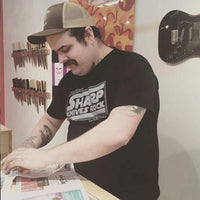
Western Knives vs Japanese Knives: A Primer
Anthony Bourdain taught a younger version of me that a serious cook only needed four knives: a paring knife, a chef’s knife, a flexible boning knife, and an offset bread knife. He wrote in Kitchen Confidential that he really liked Global Knives, so I bought Globals. They were my first non-European knives, and I loved them. Prior to that, I used Victorinox knives—ordered through Chef Hans Anderegg with rosewood handles—and loved them, too. My first knife to call my own is a now-ragged 10” Sanelli, its chunky green and red handle pockmarked from when my Great Dane stole it and tried to rob our dinner guests for pocket change and table scraps. I never loved that knife.
As a group of people who spend all day waxing poetic about Japanese knives, it’s hard to make time for knives from the rest of the world. Great blades come to us from Europe and North America, we sharpen them all and do a damn good job too, but it’s important to highlight some differences between Western and Japanese kitchen knives.
-
The most important difference is one of materials—generally speaking, Japanese knives are made of harder steel. That makes for a sharper knife that stays sharper for longer but can be more brittle.
I'd keep a European knife handy if you chop onions like a wood splitter or regularly hammer through frozen foods, bones, and 2” x 4”-s. It’ll never get as keen of an edge and requires sharpening more often, but they are much less likely to chip.
Another reason a Japanese blade gets sharper is the angle at which it’s sharpened. When using a honing rod or sharpening stone, you’ll maintain a 15-degree angle—Western knives favour a larger angle, around 22 degrees. Harder steel allows the Japanese blade to hold this super fine edge longer.
-
An obvious difference is going to be the handles. Western knives tend to favour a riveted, full-tang handle, while a Japanese knife often uses a simple wooden handle in various shapes. Sometimes, a Western knife beefs up the heel of the knife with a bolster, a little extra steel to add some weight and something to hold.
The most important thing to consider when hmmm-ing and haw-ing over handles is what you find comfortable to hold. Nothing else really matters because both handle styles are durable; I’ve always thought that if you broke a kitchen knife handle, you’ve long destroyed the edge. A machete requires a super tough handle; a chef’s knife does not. Western-handled knives tend to feel heftier, while Japanese (or wa) handled knives are lighter. This can affect the balance point of a knife, which is only really important to know if you juggle and build Wayne Szalinski-style breakfast machines. Ideally, the balance point sits where your dominant hand naturally pinches the blade.
-
Many European chef knives, even those modelled after Japanese shapes, have more of a curve to their profile—something us nerds call the knife’s ‘belly’. Generally speaking, this blade shape suits someone who likes to leave their knife in contact with the chopping board while working. If this sounds familiar, you are looking at the spiritual grandfather to the modern gyuto.
Japanese knives, especially a santoku or nakiri, tend to have a flatter profile where more of the blade touches the cutting board during use. Someone who prefers to slide the knife is a ‘push-cut’ or ‘pull-cut’ is going to prefer this blade profile.
-
Commercially produced knives in Europe and North America favour stainless steel, so maintenance is rarely an issue, but there are exceptions. Sabatier has a line that uses carbon steel, and Zwilling has a very popular collaboration with Bob Kramer, which also uses one.
Did you know some Japanese knives can rust? As scary as this ‘carbon steel’ (or even semi-stainless) can seem, it has its benefits. These steels tend to be a bit harder (cue the broken record, “... so they stay sharp longer…”) but are easier to sharpen thanks to the molecular structure of the metal itself—something I trust to be true but know almost nothing about myself. They also age beautifully, building a distinct patina over the years like a good leather jacket.
The most important distinction when comparing Japanese and Western-style kitchen knives is the balance of sharpness and maintenance or durability. Basically, a knife gets sharper the harder the steel gets—Japanese knives generally use harder steel—but harder steel is more brittle and easy to chip or damage. I find it helpful to think about knives as cars. A western knife is a Ford truck, a Japanese knife is a Ferrari, and sharpness is speed. An F-150 will never beat a Ferrari off the line, but you’re not afraid of potholes driving the truck.
So keep that old Wushtof or Victorinox around. They’re great backup to a more delicate blade, and having something sturdy around for your guests to use never hurts.





